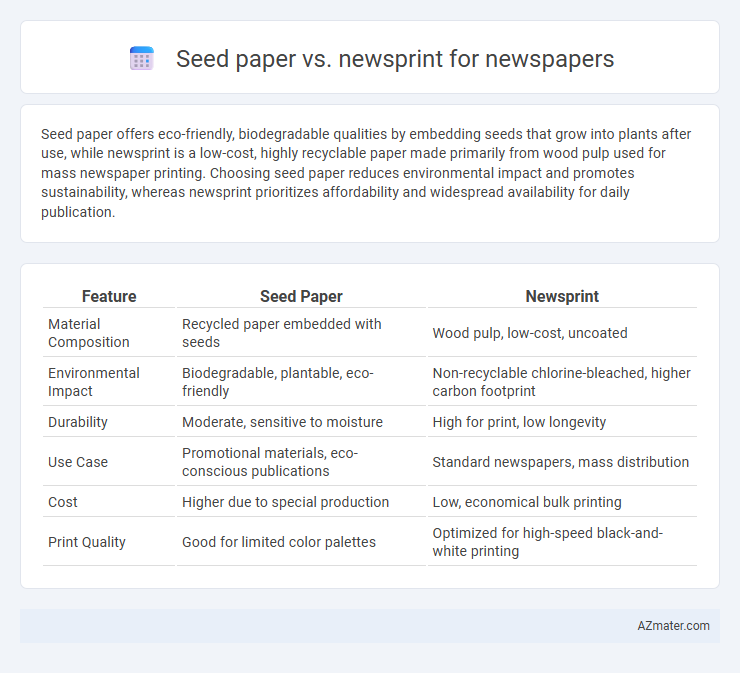Seed paper offers eco-friendly, biodegradable qualities by embedding seeds that grow into plants after use, while newsprint is a low-cost, highly recyclable paper made primarily from wood pulp used for mass newspaper printing. Choosing seed paper reduces environmental impact and promotes sustainability, whereas newsprint prioritizes affordability and widespread availability for daily publication.
Table of Comparison
| Feature | Seed Paper | Newsprint |
|---|---|---|
| Material Composition | Recycled paper embedded with seeds | Wood pulp, low-cost, uncoated |
| Environmental Impact | Biodegradable, plantable, eco-friendly | Non-recyclable chlorine-bleached, higher carbon footprint |
| Durability | Moderate, sensitive to moisture | High for print, low longevity |
| Use Case | Promotional materials, eco-conscious publications | Standard newspapers, mass distribution |
| Cost | Higher due to special production | Low, economical bulk printing |
| Print Quality | Good for limited color palettes | Optimized for high-speed black-and-white printing |
Introduction to Seed Paper and Newsprint
Seed paper is an eco-friendly alternative to traditional newsprint, embedded with seeds that can be planted after use, promoting sustainability and greenery. Newsprint, made primarily from wood pulp, is a low-cost, lightweight paper commonly used in publishing newspapers due to its high opacity and good printability. The comparison highlights seed paper's environmental benefits against newsprint's widespread use and affordability in mass media printing.
Environmental Impact of Seed Paper vs Newsprint
Seed paper significantly reduces environmental impact compared to newsprint by being biodegradable, compostable, and planted to grow into plants, which enhances soil health and reduces landfill waste. Newsprint production consumes large amounts of water, energy, and trees, contributing to deforestation, carbon emissions, and pollution from bleaching and ink chemicals. Choosing seed paper over newsprint supports sustainable forestry practices and decreases the overall carbon footprint associated with traditional newspaper printing.
Manufacturing Processes Compared
Seed paper manufacturing involves embedding biodegradable seeds into recycled paper pulp, requiring delicate processing to preserve seed viability and eco-friendly drying techniques. Newsprint production utilizes mechanical or chemical pulping of wood fibers, followed by high-speed continuous rolls and large-scale printing presses for mass circulation. Seed paper emphasizes sustainable, small-batch techniques, whereas newsprint prioritizes efficiency, durability, and cost-effectiveness in high-volume output.
Print Quality and Readability
Seed paper offers a distinct texture and organic feel but can compromise print quality due to its rough surface and embedded seeds, causing ink to spread unevenly and reducing image sharpness. Newsprint, designed specifically for newspapers, provides consistent ink absorption and clarity, enhancing readability through crisp text and clear graphics. Choosing newsprint ensures optimal print quality and legibility critical for mass distribution, whereas seed paper suits niche uses prioritizing sustainability over visual precision.
Biodegradability and Compostability
Seed paper offers superior biodegradability compared to traditional newsprint due to its embedded organic materials that break down naturally and support plant growth when composted. Newsprint, primarily composed of mechanically processed wood fibers, decomposes slower and may contain inks or additives that impact its compostability. Choosing seed paper enhances environmental sustainability by combining biodegradability with active contribution to soil health through effective compostability.
Cost Analysis: Seed Paper vs Newsprint
Seed paper generally incurs higher production costs compared to traditional newsprint due to specialized materials embedded with seeds and eco-friendly manufacturing processes. Newsprint remains more cost-effective for large-scale newspaper production because of its widespread availability and lower raw material expenses. However, seed paper can offer long-term value through sustainability benefits and potential marketing advantages despite its upfront higher price.
Accessibility and Availability
Seed paper for newspapers offers limited accessibility due to its niche production and higher costs compared to traditional newsprint, which remains widely available and affordable. Newsprint is produced in large quantities globally, ensuring consistent supply and easy access for mass newspaper printing. The established distribution channels and economies of scale make newsprint the preferred choice for most publishers seeking reliable availability.
Applications Beyond Newspapers
Seed paper, embedded with biodegradable seeds, offers innovative applications beyond traditional newspaper use, such as in eco-friendly marketing materials, greeting cards, and promotional flyers that encourage planting and sustainability. In contrast, newsprint remains optimal for mass production and cost-effective dissemination of information but lacks the environmental regeneration benefits of seed paper. Industries aiming for green branding increasingly prefer seed paper to align with eco-conscious consumer values while maintaining print functionality.
Consumer Perception and Engagement
Seed paper in newspapers enhances consumer perception by promoting environmental sustainability, leading to increased brand loyalty and positive engagement among eco-conscious readers. Newsprint, while cost-effective and traditional, often lacks the innovative appeal that drives consumer interaction and differentiated market positioning. Incorporating seed paper can boost reader retention rates by aligning content delivery with growing demands for green, recyclable materials.
Future Trends in Newspaper Materials
Seed paper is gaining traction as an eco-friendly alternative to traditional newsprint, offering biodegradable and plantable properties that reduce waste and promote sustainability in the newspaper industry. Innovations in seed-infused newsprint are expected to drive future trends, appealing to environmentally conscious readers and publishers aiming to lower their carbon footprint. Despite challenges in cost and durability, the integration of seed paper aligns with the growing demand for green materials in print media, heralding a shift towards more sustainable newspaper production.

Infographic: Seed paper vs Newsprint for Newspaper
 azmater.com
azmater.com